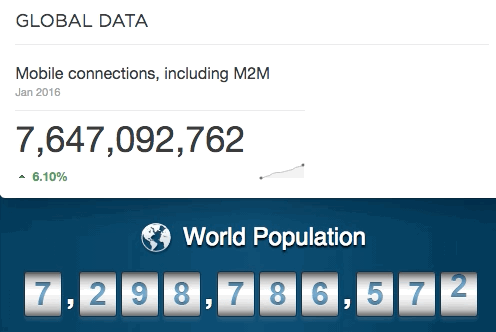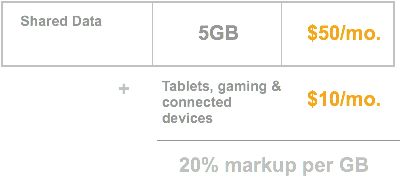Questions to Carriers: Why do You Charge to Share Data Between Devices?

The number of connected devices in the world overtook the number of people on earth in 2014. The same year, nearly half a billion new connected devices were activated. Among those device activations were smartphones, tablets, mobile hotspots and wearables to name a few. And all those newly-connected devices helped boost mobile data traffic by 55% (pdf) around the world over the next year.

90% of Americans already own a cell phone, 68% being smartphones. So mobile carriers are actually beginning to run out of new customers in the US. Because they want to keep growing, carriers want current customers to buy more devices that need connectivity. And they want those customers to connect said devices to their existing mobile plans.
But is adding your other connected devices to your existing mobile carrier plan really the best option? Mobile carriers typically charge monthly access fees to share data between your devices. But why? Customers aren’t accessing extra benefits. Just the data they will pay for even if they don’t use it all.
This week, Question to Carriers seeks to determine why customers are charged to access data they are already paying for.
Let’s say you just bought a brand new tablet because you’re tired of watching Netflix on your tiny phone screen during your daily commute. You probably dropped somewhere between $300 and $1200 to acquire that shiny new piece of equipment. Now you’re itching to get it up and running, which means you need a data plan.
You have a couple of choices:
A. add the new device (or “line”) to your existing phone plan (more on the “line” tidbit later)
B. create a new plan for your device on its own
So which should you choose?
Well your mobile carrier will certainly try to convince you to add your new device to your existing plan. And at face value that doesn’t seem like a bad idea. You may have had to opt for a bigger data plan already. Remember, we discovered most carriers structure their plans in a way that pushes people to buy way more data than they really need. And since data expires, it makes sense to add another device to utilize all that extra data you had to purchase.
But If you do choose option A, prepare to tack on another $10 or $15 per month in “access” or “line” fees. That’s another $120 or $180 per year. On top of that, you can also expect to pay a one-time device “activation fee” ranging from $20-$45 depending on your carrier. And those additional fees come with no extra data. Remember you’re sharing the data you’re already paying for.
To give you some perspective:

A 20% markup per GB seems like a hefty upcharge to access a service you are already paying for doesn’t it?
Charging a “line” or “access” fee for another phone on your account seems reasonable, since carriers have to give you additional access to voice and SMS services. But charging a fee for a data-only device that only utilizes data you already purchased is completely unreasonable. You aren’t taking advantage of any of those additional services. Data-only devices can’t make cellular calls or send a traditional SMS. So why do carriers make you pay extra to access the data that should already be yours?
Mostly because they can. Not because it actually costs carriers that $10 a month to add an extra device.
So what about option B, buying an individual data-only plan for your tablet? Well, mobile carriers structure their data-only plans much like their phone data plans, which put you on the cusp of always going over or having way more data than you need. Individual data-only plans typically veer towards the latter and force you to buy more data than you actually need for a secondary device. For example, AT&T’s data-only plans start at 4GB.
“Many smartphone users globally are buying larger monthly data plans than they need. On average, 53% of 3G smartphone subscribers and 48% of 4G smartphone subscribers used half or less of their data plan in December [2014].”
via study done by Mobidia/Ovum January-December 2014
If that’s the case, all of a sudden data-sharing seems a lot more tempting. Meaning, *somehow* mobile carriers have made it *appealing* to pay extra to access data that you already paid for. Or to put it another way, for a surcharge carriers let you reduce all that unused data or “breakage” you probably incurred from buying a bigger data plan by adding an extra device.
Imagine if your electricity provider charged you an extra fee every time you plugged in a new appliance. That sounds crazy doesn’t it? Well, that is exactly what mobile carriers are doing.
Whether it is “device access fees”, “data expiry breakage”, phone financing programs or early termination fees, mobile carriers are constantly finding new and creative ways to extract more money from their customers. The growth in new connected mobile devices only establishes another path for carriers to get into their customers’ pockets.